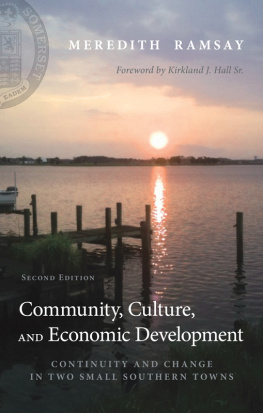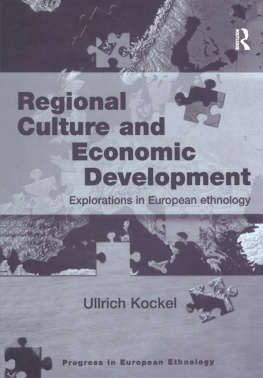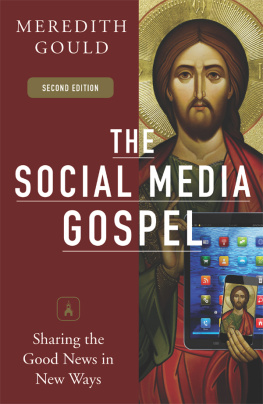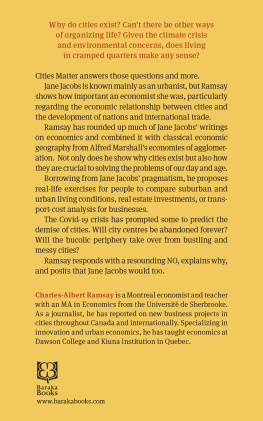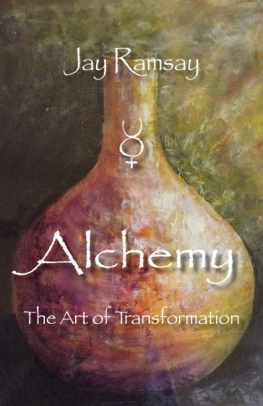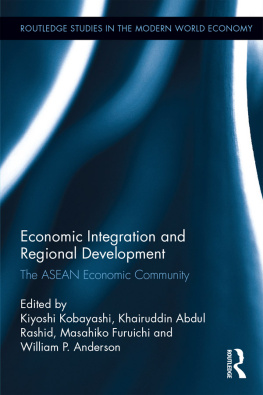Community, Culture,
and Economic Development
S ECOND E DITION
Community, Culture,
and Economic Development
Continuity and Change in Two Small Southern Towns
S ECOND E DITION
MEREDITH RAMSAY
Foreword by
Kirkland J. Hall Sr.
Published by State University of New York Press, Albany
2013 State University of New York
All rights reserved
Printed in the United States of America
No part of this book may be used or reproduced in any manner whatsoever without written permission. No part of this book may be stored in a retrieval system or transmitted in any form or by any means including electronic, electrostatic, magnetic tape, mechanical, photocopying, recording, or otherwise without the prior permission in writing of the publisher.
For information, contact State University of New York Press, Albany, NY
www.sunypress.edu
Production by Ryan Morris
Marketing by Michael Campochiaro
Library of Congress Cataloging-in-Publication Data
Ramsay, Meredith, 1937
Community, culture, and economic development : continuity and change in two small southern towns / Meredith Ramsay ; foreword by Kirkland J. Hall Sr. Second edition.
pages cm
Includes bibliographical references and index.
Summary: Newly updated comparative study of economic development policy, and its relationship with local power structures and cultural and social relations, in two Maryland townsProvided by publisher.
ISBN 978-1-4384-4887-9 (hardcover : alk. paper)
1. Community developmentMarylandSomerset County. 2. Economic developmentSocial aspectsMarylandSomerset County. 3. Social action MarylandSomerset County. I. Title.
HN79.M32S67 2013
307.1'40975223dc23
2013000108
10 9 8 7 6 5 4 3 2 1
For Marymor Cravens,
with gratitude and deepest affection
Contents
Foreword
It is with a deep sense of gratitude that I write this foreword to the second edition of Community, Culture, and Economic Development, for it was indeed a blessing that Meredith Ramsay decided to write about our quiet rural community of Somerset. Her first edition confirmed the sad realities that we who live here had always known but lacked the resources to change. It chronicles our efforts over the years to work with the county government and school system to build a more just society and a better future for our children in this place that we love.
The book recounts how Christopher Brown of the American Civil Liberties Union worked with Somersets black community in 1985, when we filed our first voting rights lawsuit. It describes our success in electing the first African American to sit on the Princess Anne Town Commission. And it tells of our many unsuccessful attempts to elect a candidate of our choice to the Somerset County Board of Commissioners.
When I became president of the NAACP Somerset Branch for the first time, in 1991, I knew there was much more to be done. But it was not until the first edition of this book came out five years later that I and others realized how to approach the problem of African American disenfranchisement here. With a model for change now in place, we once again joined forces with the American Civil Liberties Union, specifically with lead attorney Deborah Jeon and legal program administrator Amy Cruise.
When my term as NAACP president was up, we were fortunate that those who came after me, Elder Craig Mathies (who was to become our first black county commissioner) and longtime political activist Kenneth Ballard continued the struggle. After more lawsuits, research, and presentations, the historic document called the Semper Eadem Report (semper eadem is Latin, meaning always the same) was the straw that finally broke the camels back, so to speak. It is a research reportproduced by the Somerset NAACP in collaboration with the Maryland ACLUthat documents egregious racial disparities in our county government and school system. That is, it documents the legacy of racism that for 350 years had barred African Americans from the top tier of public office or any of the countys better appointed positions. That was the breakthrough that some of us had been working for all of our adult lives.
Fifteen years after the first edition was published, our county has made tremendous strides toward racial equality. I firmly believe, from the standpoint of a scholar of organizational leadership and as a resident of Princess Anne who was intimately involved in the struggle, that we could not have succeeded in making those changes were it not for the inspiration we gained from this book. It exposed age-old practices in Somerset County that were badly in need of reform. It provided the impetus to create a better community for us all, regardless of race or ethnicity. We still have a distance to go, but as we continue on the road to equality, we rejoice in knowing that Somerset County is iam non eundemLatin meaning no longer the same.
With publication of the second edition, it is now possible for all to see what can be accomplished with well-documented information, a thoughtful plan of action, a team of dedicated legal experts, and the perseverance of ordinary citizens. With this, and a modicum of faith, all things are possible. The first edition was our guide, and the second edition lays out what we accomplished and how we accomplished it, so that others might have the benefit of our experience. The people of Somerset, the African American community in particular, owe a debt of gratitude to Meredith Ramsay for being courageous enough to ask the hard questions.
Kirkland J. Hall Sr.
University of Maryland Eastern Shore
Preface to the Second Edition
The first time I ventured into Somerset County in 1985, I might as well have entered a parallel universe. Nothing had prepared me for the incongruities that I observed there. The very atmosphere of the place felt Kafkaesqueominous and confusing. (To one observer, the society seemed almost feudal.) Why, I wondered, in the poorest county in Maryland, was there deep ambivalence about economic development in Crisfield, the poorest of the countys two towns. And why, in a county where African Americans accounted for 38 percent of the population, had no black ever been elected or appointed to a top countywide position since Somerset was founded in 1666?
Somerset County is largely unknown to outsiders. It is the southernmost county on Marylands Eastern Shore of the Chesapeake Bay, where centuries of geographical isolation have produced self-reliant communities that are distrustful of strangers and resistant to change. Indeed, it was astonishing to realize how successfully the old ruling families had inoculated their insular realm against the powerful social forces of the twentieth century. And how remarkably apt that its heraldic shield bears the quaint Latin motto, Semper Eademmeaning Always the Same.
Nothing in life is immutable, though, as Somersets governing group learned in 2010. Seeds of dissatisfaction sown many years earlier had by then matured and begun to bear fruit. When I learned the full scope of the change that had happened, I had been in retirement for quite some time, never contemplating a second edition. But as Ronald Walters said, we know hardly anything about black leadership at the grassroots and in small communities. So I came to believe that this story was important enough that it had to be told.
I have described how these changes occurred in the epilogue, and I have also updated some aspects of the original study. But first a word about this book as a whole. Until 1985, I had never set foot on Marylands Needing to understand the strange reality that, like Alice in Wonderland, I had stumbled into, I returned the following year to investigate these anomalies for my doctoral research. I am frequently asked whether I have some kind of personal connection to Somerset County. The answer is no: quite simply, these places intrigued me.


